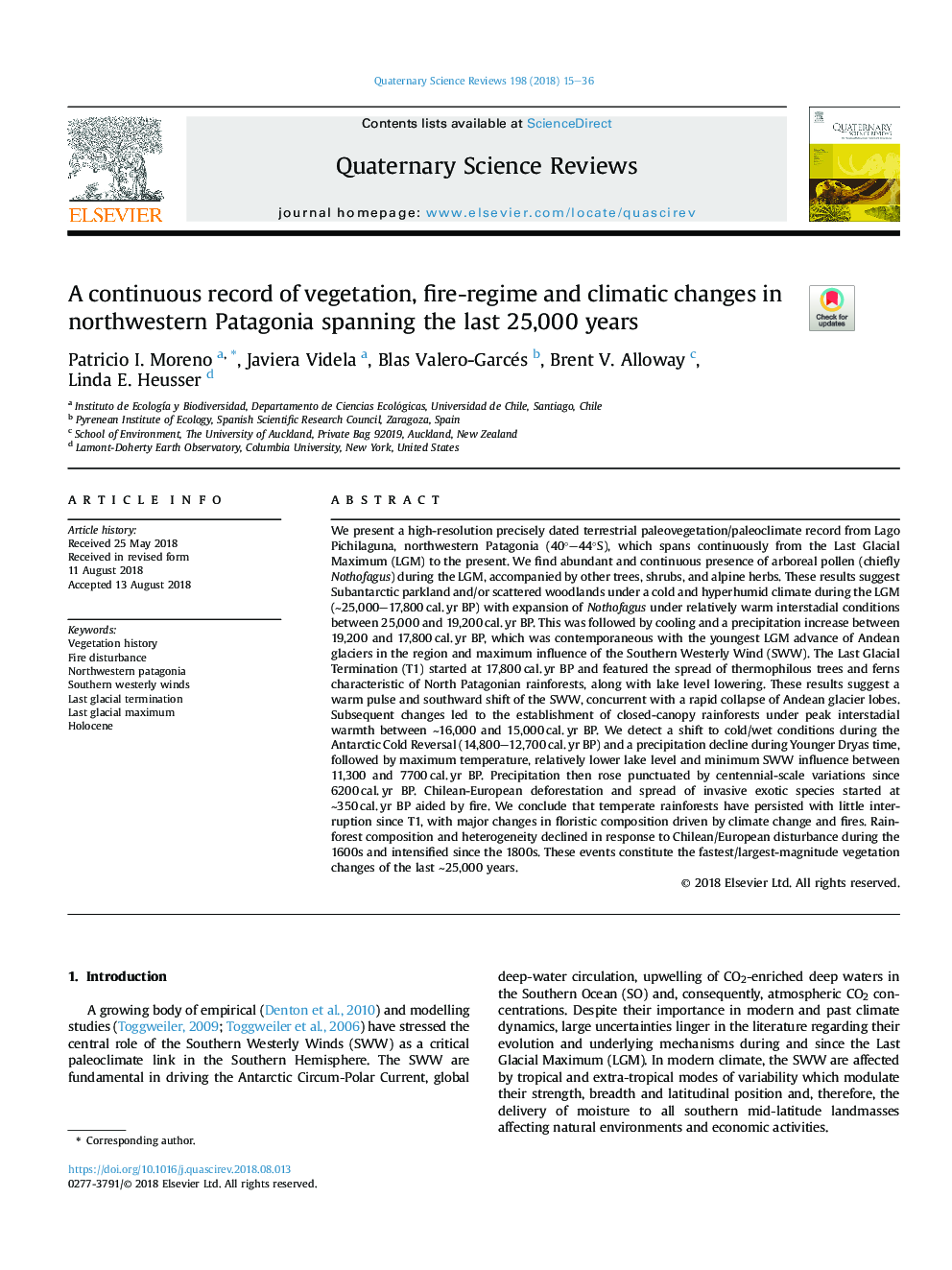| کد مقاله | کد نشریه | سال انتشار | مقاله انگلیسی | نسخه تمام متن |
|---|---|---|---|---|
| 8966185 | 1646784 | 2018 | 22 صفحه PDF | دانلود رایگان |
عنوان انگلیسی مقاله ISI
A continuous record of vegetation, fire-regime and climatic changes in northwestern Patagonia spanning the last 25,000 years
ترجمه فارسی عنوان
یک گزارش مداوم از پوشش گیاهی، رژیم آتش سوزی و تغییرات اقلیمی در شمال غربی پاتاگونیا که در 25000 سال گذشته قرار دارد
دانلود مقاله + سفارش ترجمه
دانلود مقاله ISI انگلیسی
رایگان برای ایرانیان
کلمات کلیدی
تاریخ گیاه شناسی، اختلال در آتش، پاتاگونیا شمال غربی، باد جنوب غربی، آخرین ختم یخبندان، آخرین حداکثر یخبندان هولوسن،
موضوعات مرتبط
مهندسی و علوم پایه
علوم زمین و سیارات
زمین شناسی
چکیده انگلیسی
We present a high-resolution precisely dated terrestrial paleovegetation/paleoclimate record from Lago Pichilaguna, northwestern Patagonia (40°-44°S), which spans continuously from the Last Glacial Maximum (LGM) to the present. We find abundant and continuous presence of arboreal pollen (chiefly Nothofagus) during the LGM, accompanied by other trees, shrubs, and alpine herbs. These results suggest Subantarctic parkland and/or scattered woodlands under a cold and hyperhumid climate during the LGM (â¼25,000-17,800â¯cal.â¯yr BP) with expansion of Nothofagus under relatively warm interstadial conditions between 25,000 and 19,200â¯cal.â¯yr BP. This was followed by cooling and a precipitation increase between 19,200 and 17,800â¯cal.â¯yr BP, which was contemporaneous with the youngest LGM advance of Andean glaciers in the region and maximum influence of the Southern Westerly Wind (SWW). The Last Glacial Termination (T1) started at 17,800â¯cal.â¯yr BP and featured the spread of thermophilous trees and ferns characteristic of North Patagonian rainforests, along with lake level lowering. These results suggest a warm pulse and southward shift of the SWW, concurrent with a rapid collapse of Andean glacier lobes. Subsequent changes led to the establishment of closed-canopy rainforests under peak interstadial warmth between â¼16,000 and 15,000â¯cal.â¯yr BP. We detect a shift to cold/wet conditions during the Antarctic Cold Reversal (14,800-12,700â¯cal.â¯yr BP) and a precipitation decline during Younger Dryas time, followed by maximum temperature, relatively lower lake level and minimum SWW influence between 11,300 and 7700â¯cal.â¯yr BP. Precipitation then rose punctuated by centennial-scale variations since 6200â¯cal.â¯yr BP. Chilean-European deforestation and spread of invasive exotic species started at â¼350â¯cal.â¯yr BP aided by fire. We conclude that temperate rainforests have persisted with little interruption since T1, with major changes in floristic composition driven by climate change and fires. Rainforest composition and heterogeneity declined in response to Chilean/European disturbance during the 1600s and intensified since the 1800s. These events constitute the fastest/largest-magnitude vegetation changes of the last â¼25,000 years.
ناشر
Database: Elsevier - ScienceDirect (ساینس دایرکت)
Journal: Quaternary Science Reviews - Volume 198, 15 October 2018, Pages 15-36
Journal: Quaternary Science Reviews - Volume 198, 15 October 2018, Pages 15-36
نویسندگان
Patricio I. Moreno, Javiera Videla, Blas Valero-Garcés, Brent V. Alloway, Linda E. Heusser,
